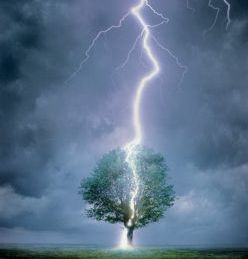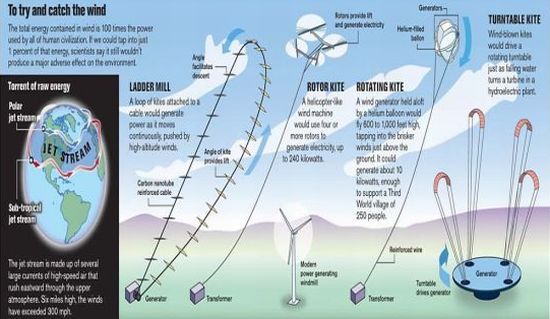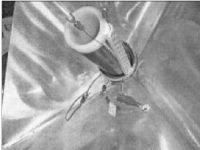
Earth’s atmosphere is in itself an infinite storeroom of energy. The regular diurnal variations of the Earth’s electromagnetic network produce strong electric currents on a gigantic scale. The Earth has its own negative electricity while the atmosphere is positively charged. The electric potential increases with the altitude, hence the electric force is proportional to the atmospheric altitude. In the present times, where alternative energy holds the key to the energy crisis, the abundance of this source of energy has attracted the researchers’ attention. Evermore exciting is its free availability in air and clouds. There have been efforts to capture it since long but a considerable success is still hard to come by.
Atmospheric Electricity, nature lends it for nothing:
All atmospheric electricity is a result of the potential difference between any point on the surface of the negatively charged earth and the other in the positively charged air above it. Earth’s electromagnetic network consists of thunderstorms, the electrification of the air in a combined or uncombined state and the polar Aurora effects. Equator experiences more of thunderstorms than anywhere on the entire planet. These thunderstorms express themselves in the form of lightning and atmospheric pressure, wind levels, solar winds and the solar particles. Estimates reflect that lightning strikes somewhere on the surface of the Earth about 100 times every second. 
Secondly, the Polar Aurora provides a great natural spectacle and is an outcome of the atmospheric electricity. Earth’s magnetosphere abounds in profuse solar-wind-transferred-energy, which is visible from the polar regions of the planet.
Moreover, this simple, robust and low cost electricity is much cheaper than wind turbines. You don’t have to count on the weather conditions, and it’s available day and night. No doubt, it’s in abundance at the poles but that doesn’t deny its presence elsewhere.
Feasible ways to capture it:
Capturing Atmospheric Electricity means to exploit the natural electrostatic potential gradient of the Earth. The electrostatic potential gradient between the Earth and the ionosphere is about 100Vm-1 near the surface in summer and 300Vm-1 in winter. Electrically charging a bank of capacitors or operating an electrostatic motor/parametric conversion machine are some of the possible ways to convert this static atmospheric electricity into conventional Alternating Current.

Image Source: SFGate
1) Tapping the Jet Streams:
The jet streams generally blow at speeds up to 310 mph over the northern hemisphere and are a possible source of atmospheric electricity. If the researchers could succeed in tapping these ferocious winds, the world’s entire electrical needs can be met. Scientists believe that a kite-like wind-power generator, lobbed into the upper atmosphere to capture the power of the jet stream, can produce energy, which is transmittable to Earth via aluminum or copper cables or invisible microwave beams. Next step includes its storage and transmission to target consumption points. The energy generation via the jet streams involved the inclusion of the designs enlisted below:
a. Ladder Mill: Rowing against the high-altitude winds, kites attached to a cable could generate a sizeable amount of power.
b. Rotor Kite: A unique machine design includes more than four rotors to generate electricity, up to 240 kilowatts.
c. Rotating Kite: The concept lies deep-rooted in conception of a wind generator at 600 to 1,000 feet. A helium balloon keeps the kite in the air. The proposed electrical generation is about 10 kilowatts.
d. Turntable Kite: Though no data on the projected capacity is available, a rotating turntable still ensures better power generation.
2) Through Aerostats, as suggested by Dr. Plauson in 1920:
Dr. Hermann Plauson, the director of the Fischer-Tropsch “Otto Traun Research Laboratories” in Hamburg, Germany during the Weimar Republic of the 1920s, drew on the aerostats made from magnesium-aluminum alloy. Some electrolytically deposited needles, further doped with radium, perforated the aerostat all through it. Patched with zinc amalgam, the aerostat went on to produce 0.72kW and 3.4kW 300m above ground level. The power could further be increased up to 81-1/2 kilowatts in 24 hours by using two balloons with a special condenser battery.
3) The Pyramidal Electric Transducer:

Inspired by the Great Pyramid of Giza (GPG), a Californian researcher, Peter Grandics says that pyramidal horn antennas suitably detect the short-pulse waveforms. Fed by the hypothesis, a pyramidal antenna, modeled on the GPG, can transfer the electrostatic discharge into a resonant circuit. While coupling into the atmosphere, it effectively converts the random impulses into an alternating current. Resultantly, it has the potential to utilize the renewable electric power.
Remarkable technology has some obstructions:
Moreover, this simple, robust and low cost electricity is much cheaper than the wind turbines. You don’t have to count on the weather conditions and it’s available day and night. Frequent use of this technology will definitely lead to the discharge of storm clouds and the risk of lightning strikes will get minimized. No doubt, it’s in abundance at poles but that doesn’t deny its presence elsewhere.
Despite it’s being a feasible energy source, there are certain hitches scientists need to deal with:
I. As this technology makes use of tethers, it’s hazardous to aircraft. On the contrary, you can’t compromise even on the tether’s thickness since density means more output. As a direct consequence, it necessitates bigger balloon size and more maintenance.
II. Like the airplanes, the balloons are also defenseless when it comes to bad weather. So, as is the case with wind and solar power, adverse weather conditions play a role here also.
III. At 200 meters or above altitudes, the amassed charge goes far beyond the wires’ potential. It requires electrical insulation around the wire to avoid the energy loss.
IV. After you’ve exploited the device for quite sometime, the electrical potential goes down drastically. It further hurts the ionization capability of the device. Therefore, it requires extending of the surface electrical field via the use of very thin wires.
V. Finally yet importantly, it’s imperative to design a balloon ionizer/collector with higher current density.

